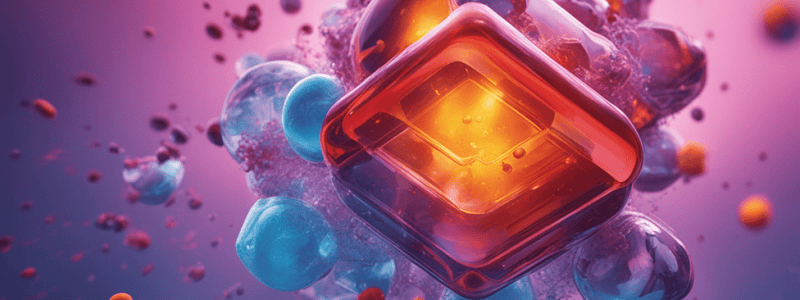Podcast
Questions and Answers
Что характеризует газообразное состояние вещества?
Что характеризует газообразное состояние вещества?
- Высокая плотность
- Слабые межмолекулярные силы (correct)
- Фиксированная форма
- Сильная ионная связь между частицами
Что происходит при фазовом переходе от жидкого к газообразному состоянию?
Что происходит при фазовом переходе от жидкого к газообразному состоянию?
- Эволюция (correct)
- Конденсация
- Замерзание
- Расплавление
Что характерно для плазмы как состояния вещества?
Что характерно для плазмы как состояния вещества?
- Нет проводимости электричества
- Частицы ионизированы (correct)
- Стабильная структура
- Слабая теплопроводность
Что происходит при фазовом переходе от газообразного к твердому состоянию?
Что происходит при фазовом переходе от газообразного к твердому состоянию?
Что является ключевым при понимании поведения материалов при различных условиях?
Что является ключевым при понимании поведения материалов при различных условиях?
Что характеризует твердое состояние?
Что характеризует твердое состояние?
Что отличает жидкое состояние от твердого?
Что отличает жидкое состояние от твердого?
Чем газы отличаются от твердых и жидких веществ?
Чем газы отличаются от твердых и жидких веществ?
Что происходит при фазовом переходе от жидкости к газу?
Что происходит при фазовом переходе от жидкости к газу?
Что характеризует плазму?
Что характеризует плазму?
Study Notes
Exploring Aggregate States of Matter: Solid, Liquid, Gas, Plasma, and Phase Transitions
The field of physical chemistry is built upon our understanding of the various states that matter can assume as it transitions between solid, liquid, gas, and plasma. These aggregate states are interconnected, and they significantly influence the properties and behavior of substances under different conditions.
1. Solid State (Твердое Состояние)
Solids are characterized by a rigid structure and fixed positions of their constituent particles. They have a definite shape and volume and resist changes in shape when an external force is applied. In solids, the particles are tightly packed and held together by strong intermolecular forces, such as ionic, covalent, and metallic bonds.
2. Liquid State (Жидкое Состояние)
Liquids are characterized by a lack of rigidity and fixed positions of their particles. They maintain their shape, but they take the shape of the container they are in. In liquids, the particles are more loosely packed than in solids, but they are still held together by the same intermolecular forces. The particles can slide past each other, allowing the liquid to change shape.
3. Gas (Газообразное Состояние)
Gases are characterized by their ability to expand indefinitely and to fill the shape of the container they are in. The particles in gases are highly dispersed and have more kinetic energy than in solids or liquids. Intermolecular forces between the particles in gases are much weaker than in solids and liquids, so the particles move freely, and the gas easily changes shape.
4. Plasma (Плазма)
Plasma is the most rarefied and ionized state of matter, and it is formed when a gas is subjected to high temperatures and/or ionizing radiation. In plasmas, the particles are ionized, which means that the electrons are separated from their nuclei. Plasmas are highly conductive and can conduct electricity. They are found naturally in the Earth's upper atmosphere and artificially in fusion reactors.
5. Phase Transitions
Phase transitions occur when a substance changes its state, such as when a solid melts to become a liquid, or when a liquid vaporizes to become a gas. These transitions are governed by the principle of Le Chatelier's Principle and the Gibbs phase rule. Phase transitions are essential to understanding the behavior of materials under various conditions, such as temperature, pressure, and concentration changes.
Phase transitions can be classified into three main types:
- Melting (расплавление): Solid to liquid transition
- Freezing (замерзание): Liquid to solid transition
- Vaporization (эволюция): Liquid to gas transition
- Condensation (конденсация): Gas to liquid transition
- Sublimation (переход прямого превращения): Solid to gas transition
- Deposition (осаждение): Gas to solid transition
In conclusion, our understanding of the different aggregate states of matter and their phase transitions is fundamental to the development and application of various technologies and industries, such as materials science, chemical engineering, and environmental science. By expanding our knowledge of these topics, we can better predict and control the behavior of materials and the natural world.
Studying That Suits You
Use AI to generate personalized quizzes and flashcards to suit your learning preferences.
Description
Проверьте свои знания о различных состояниях вещества - твердых, жидких, газовых, плазменных и фазовых переходах. Узнайте о характеристиках, свойствах и поведении веществ в каждом состоянии и поймите принципы, регулирующие фазовые переходы.




